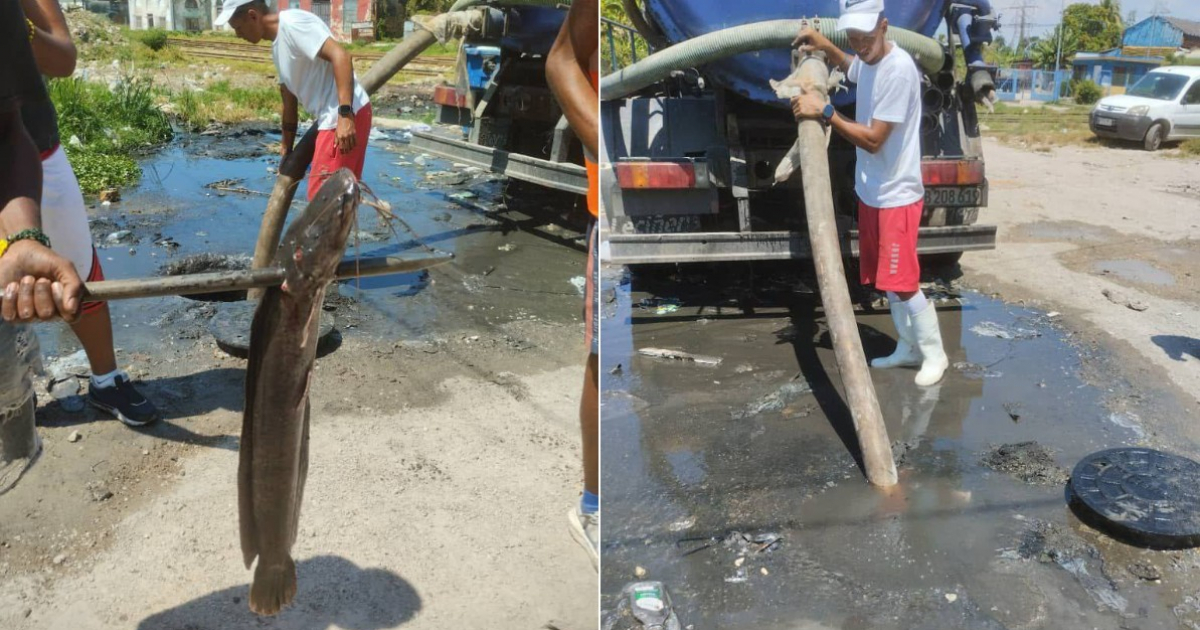In a recent post on its official Facebook page, Aguas de La Habana shared a viral image of a worker holding a large catfish removed from a sewer in the Antonio Maceo community, located in the 10 de Octubre municipality. This unexpected event took place during the Meteoro 2025 disaster preparedness drill, aimed at testing the nation's readiness for natural disasters, particularly with the hurricane season beginning on June 1.
The post, which featured sanitation crews using high-pressure vehicles to clean sewers and drains, had a triumphant tone, emphasizing the nation's preparedness for meteorological emergencies. However, many Cubans met it with irony, as such sewer cleanings seem to occur only right before the hurricane season or during drills like Meteoro 2025.
An image of a worker holding the catfish serves as a stark reminder of the poor state of the sanitation system, rather than its efficiency, despite the fish's impressive size. Seemingly aware of potential ridicule, Aguas de La Habana disabled comments on the post, possibly to avoid mockery, given that the catfish is often one of the few protein sources available amid the country's severe food crisis.
A Seasonal Cleanup Effort Amidst Water Shortages
While the Cuban government boasts about its disaster preparedness, Havana's residents, along with those in other provinces, continue to grapple with chronic water shortages. This issue is not solely due to drought but also stems from the deteriorating state of the water infrastructure, filled with leaks and outdated systems, causing significant water loss before it reaches homes.
The situation presents a paradox: media efforts highlight the country's readiness for hurricanes, yet the underlying problems of inadequate infrastructure and maintenance persist. Drainage cleanups and sewer repairs occur only during these "emergency" times or just before the cyclone season, demonstrating a severe disconnect between the image portrayed to the world and the daily reality faced by the Cuban populace.
Image Over Substance: The Realities of Meteoro 2025
The execution of Meteoro 2025, which includes evacuation drills and technical resource deployment, is perceived by many as a facade rather than a genuine attempt to improve the nation's hydraulic and sanitation systems. The regime avoids addressing its historical responsibility for the repair and modernization of essential infrastructure, opting instead for short-term visible actions like these drills, while structural issues remain unresolved.
Meanwhile, the Cuban Institute of Meteorology (INSMET) has forecasted the arrival of the season's first tropical wave, bringing rain and storms to the country. In response, sewer cleaning and drain unblocking brigades present a last-minute effort to mitigate the effects of an approaching hurricane season, seemingly without a genuine action plan to protect the population.
Although the Cuban government has allocated resources to "demonstrate" its preparedness, the reality is that infrastructure readiness is minimal and often limited to the visibility of these temporary efforts, lacking consistent follow-up or maintenance. Government responses appear to be more about media pressure and public concerns than providing real and effective solutions to the deficiencies in the sanitation system.
Addressing the Underlying Issues
While Aguas de La Habana congratulates itself on cleaning a sewer and extracting a fish, citizens still struggle with the lack of potable water, poor sanitation services, and flood risks. The absence of a comprehensive maintenance and modernization policy for hydraulic infrastructure, affecting both the capital and the rest of the country, remains one of the nation's most pressing issues.
The Cuban government, more concerned with its image through media exercises, has failed to offer lasting solutions to the fundamental problems that Cubans face daily. Cleaning sewers just before the hurricane season, when rain and storms are imminent, is merely a temporary fix that highlights the lack of foresight and negligence in managing crucial infrastructure.
The Cuban people deserve a more serious, structural, and effective response. Solidarity during crises holds value, but the lack of governmental attention to basic infrastructure and public service problems is a clear symptom of a system that prioritizes appearance over substance.
Understanding Cuba's Infrastructure Challenges
What is the significance of the catfish extraction in Havana?
The extraction of the catfish highlights the poor conditions of Havana's sanitation system rather than its efficiency.
Why is the sanitation system's condition a problem for Cuba?
The deteriorating infrastructure leads to significant water loss, contributing to chronic water shortages and poor sanitation services.
How does the Cuban government handle infrastructure maintenance?
The government tends to prioritize short-term visible actions over addressing long-standing structural issues.
